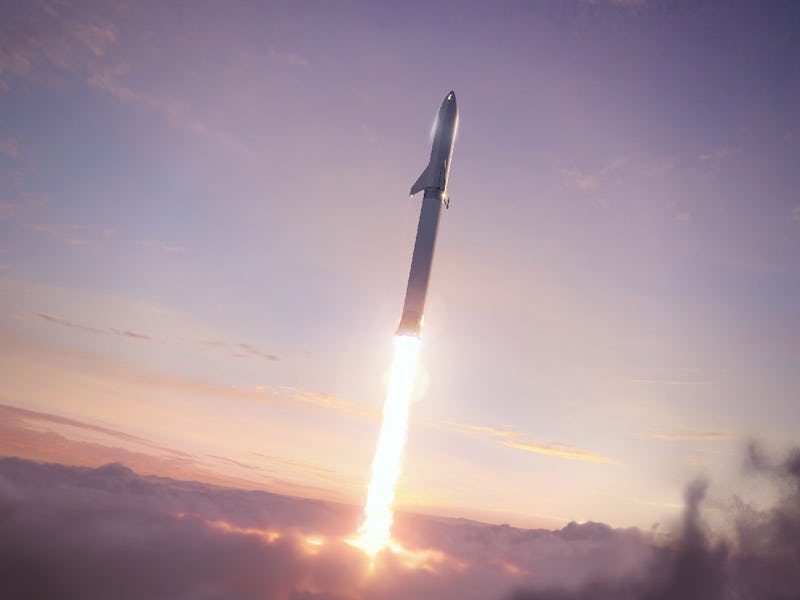SpaceX: Elon Musk Teases Rapid, Cheap Raptor Production to Get to Mars Fast
Musk has an ambitious timetable in mind.

SpaceX is planning to give its Mars-bound Raptor engine design a big production boost, CEO Elon Musk teased in a series of Twitter posts Monday. By the end of this year, Musk declared, the company is aiming to produce a new engine every 12 hours.
The engine is designed for the Starship, a stainless steel vessel currently under construction that could send the first humans to Mars. Production on the first set of Raptor engines has been cautious, with the company delivering the first finalized engine in January 2019 and producing four more to the present day. That’s nowhere near enough to get to Mars; each Starship “Super Heavy” booster uses 31 engines, while the main ship uses a further seven engines.
Musk suggested on Twitter that SpaceX is set to ramp up production for the engine “exponentially” soon. The sixth engine is almost done, and the firm is “aiming for an engine every 12 hours by end of year.” This should equate to around 500 engines per year, as Musk explained that a full year of production is around 70 percent of the peak daily rate.
“Accelerating Starship development to build the Martian Technocracy,” Musk declared, followed up by a reference to Monty Python: “Anarcho-syndicalism FTW!!”
A Raptor engine test fire.
SpaceX Raptor: Price Set to Drop Dramatically
The engine is also set to decrease in price as production scales. Musk confirmed that each engine currently costs more than $2 million. He suggested that the figure would reduce tenfold, which could mean an engine costs just $200,000.
That’s not all. Because each Raptor produces 200 tons of force, the cost per ton of force would equate to around $1,000. But because each engine is designed to be reused around 1,000 times with little maintenance, the true cost per ton per flight would equate to around $1.
SpaceX Raptor: How Reusing Rockets Has Led to Lower Prices
SpaceX has made reusing rocket components a major focus of its business, and it’s in these advancements that the focus pays off. The company has flown a total of 79 launches and landed 41 cores in total. Its first and only attempt in 2013 was a failure, but by 2017, it attempted to land 15 Falcon 9 cores and successfully recovered the component every time.
Landing the rocket booster is now routine for SpaceX, but the space industry historically built and flew rockets once. At a September 2017 conference, Musk compared this to designing an airplane with no ability to land, disposing of every plane after the journey and giving everyone a parachute to exit the flight. Musk added that “it’s really crazy we’re building these sophisticated rockets and then crash them every time they fly.”
SpaceX Starship on the moon.
The Starship is built with full reusability in mind. The Raptor engine uses liquid oxygen and methane for its fuel, unlike the Merlin engine that uses rocket propellant. That means visitors to Mars can set up a propellant plant, creating the fuel from the atmosphere to refuel the ship and return home.
“Other rocket engines were designed for no (or almost no) reuse,” Musk explained on Monday. “Raptor is designed for heavy & immediate reuse, like an aircraft jet engine, with inspections required only after many flights, assuming instrumentation shows it good. Using hydrostatic bearings certainly helps.”
SpaceX Raptor: Launch Date Comes Closer
Musk originally suggested an unmanned flight to Mars could come as early as 2022, but recent comments suggest this may come a bit later. Musk wrote on Monday that the company will “for sure” go to the “moon 1st, as it’s only 3 days away & u don’t need interplanetary orbital synchronization.”
Musk previously committed to using a Starship to send Japanese billionaire Yusaku Maezawa on a trip around the moon in 2023. The voyage will take six to eight artists on the journey, encouraging them to create pieces around their expedition.
Before these missions, the Raptor may see a real flight soon. Musk claimed in January that an orbital test flight of the Starship could arrive as early as 2020.
It remains clear that Musk’s grand ambition is to make it to Mars. He shared an image late Sunday evening of a poster with an “Occupy Mars” logo — only for followers to point out that the red celestial body in the image was the moon during the blood moon, not Mars.